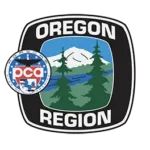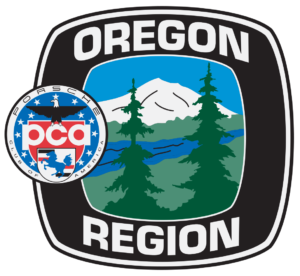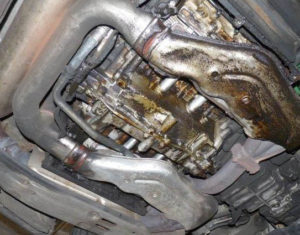 Oil leaks on an air-cooled Porsche.
Oil leaks on an air-cooled Porsche.
ORPCA was presented with a recent technical question: “I just had my Porsche in for servicing and was told my engine is leaking oil. But I’m not seeing any spots on the ground. Can you explain?”
Depending on the Porsche model, the origin of an oil leak, as well as its severity, we find that oil can travel many different paths towards the ground, but never actually hit the ground. As you can imagine, the higher the oil leak origin (ie top of engine bay vs bottom of engine bay), the more components a leak can drip onto as the leaking oil travels towards the ground. As well, once the oil leak drips onto a component, the path of the oil leak can then change, diverting the oil to a different area, away from the source of the leak. This can potentially make diagnosing some oil trails challenging, especially if the leaks are traveling down into the “great abyss.” What also makes tracing oil leaks challenging is when the leaks have been occurring for so long that oil has spread all over the bottom of the engine, transmission, and rearward. At times like this, the oil mess will need to be fully cleaned off, the engine heat cycled (and/or vehicle driven), then the source of the oil leak can be further investigated and pinpointed.
Newer water-cooled Porsches, especially a Panamera, Macan, or Cayenne, have plastic bellypans underneath the front-mounted engine as an aerodynamic aid and VERY minor protection from road grime/weather/debris. These bellypans will often catch most or all of the oil leaks and drips, unless the engine is gushing engine oil and overflows off of the bellypan. Therefore, you may never see a single drop of oil touch your garage floor. The only warning sign of an oil leak might be either oil consumption during your oil change period (i.e. having to add oil in between oil changes), and/or the smell of burning oil.
Burning oil brings up an important safety warning. What happens when hot oil contacts a hot exhaust component? Not a whole lot of good, that’s for sure. Is it possible for an oil leak to cause a fire? You betcha! This is certainly one of the worst-case scenarios for oil leaks, along with internal engine damage if the engine were to run out of oil. What other repercussions can occur from oil leaks? As mentioned above, when oil leaks onto other components, especially rubber components, it can cause the rubber to swell. The rubber becomes squishy, and the rubber component degrades quicker. That means more repair costs. Speaking of increased costs, oil leaking onto the ground is simply money leaking out of your pocket, as you have to top up the engine oil level more often. In relation environmental impact, once the rains come, any oil leaking onto the ground will eventually make its way into the groundwater and/or sewer drains, leaching into streams and rivers.
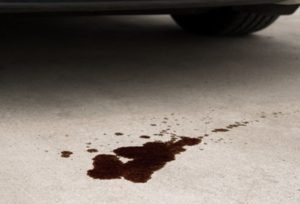 Oil Drips.
Oil Drips.
What are the common oil leaks for some of the Porsche models? Working our way from newer to older models, both the Macan and Cayenne V6 are suffering from timing cover leaks. The front timing cover bolts are over-torqued at the factory, the bolts break off, then the covers leak. Below is a snapshot of the fun we’re having with one of these repairs right now.
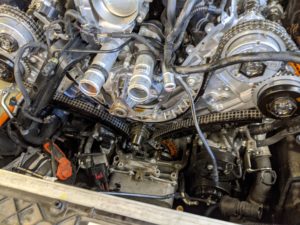 Cayenne V6 timing cover leak repair.
Cayenne V6 timing cover leak repair.
We have found the 997.2 and 991-series 911s to be fairly dry thus far.
The 986 Boxsters and 996-series 911s have the infamous IMS (intermediate shaft) plate and/or RMS (rear main seal) leaks; see below for pictures of both of these issues. Also, we have seen issues with oil filler tubes, spark plug tube seals, valve adjuster solenoids, and occasionally a valve cover.
993 and 964 911s are similar in many respects as they share a similar design. Valve covers, timing covers, chain case gaskets, power steering pump drive seals are all issues that tend to occur at much lower mileage, because Porsche started to use rubber seals on a lot of these parts vs. regular “old” gaskets like on the earlier cars.
Common oil leaks on the early (pre-964) 911s include timing chain covers, valve cover gaskets, rear main seals, camshaft oil hoses, chain case gaskets, oil pressure switches, oil thermostat o-rings, and oil return tubes. On higher-mileage engines we start to see seepage from cylinder base gaskets, crankcase through-bolt o-rings. and even warped case halves on pre-‘78 air-cooled engines. Another couple of leak areas on early cars are the rear crank pulley seal and intermediate plate cover o-rings and gaskets.
Notice I mentioned the term “seepage” above. What is meant by oil seep versus oil leak? An “oil seep” would be considered a haze of moisture, more of a satin finish. No glossy finish, and no actual drips forming, thus a seep will never leave fluid on the ground, or transfer down to another component. A seep would transform into an “oil leak” when the fluid appears glossy, and/or it’s actively forming drips, which can make their way to the ground or onto other components. Compare these two pictures below;
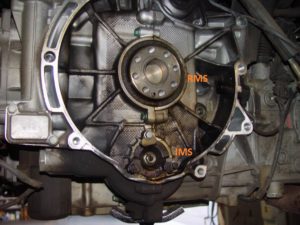 Shows the IMS plate with an oil leak due to the glossy texture.
Shows the IMS plate with an oil leak due to the glossy texture.
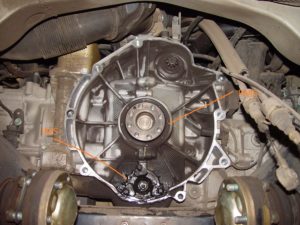 Shows the RMS with an oil seep, and the IMS plate is graduating from a seep to a leak.
Shows the RMS with an oil seep, and the IMS plate is graduating from a seep to a leak.
Engine oil is the lifeblood of your engine. Just as if you had a cut on your body and were bleeding, you’d stop the bleeding, right? If you’re experiencing an oil leak, don’t let your wonderful Porsche bleed engine oil for an extended period of time; get it remedied promptly. Your Porsche will love you for it, as will the fish in our streams.
Note; we’re in eager anticipation to see if the Taycan exhibits any oil leaks from its engine. We might be waiting awhile. 😉
Please feel welcome to ask any questions.
Jeremy Williams is the Oregon PCA Technical Editor. He co-owns Matrix Integrated (https://www.matrixintegrated.cc/) with his brother Justin. Jeremy can be reached at [email protected]


